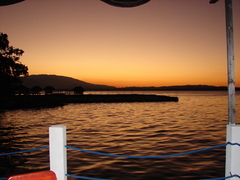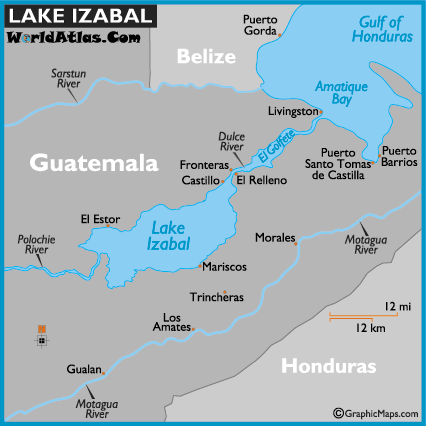Lago-De-Izabal
by V. Garth Norman
To examine these three possible name origins we will consider historic, linguistic, and geographical data.
It was in the land of Siron that Alma's son Corianton went after the notorious Lamanite harlot Isabel, which would have been in the southeastern Zarahelma-Nephi border region (Alma 39:3).
The beautiful Lago de Izabal is on the northern edge of the lower Motagua Valley's eastern fertile lowlands. It is the largest lake in Guatemala, four times the size of Lake Atitlan in the western highlands. This lake was a major connecting overland and sea trade route of the Maya that the Spanish disrupted by building a fort, Castillo de San Felipe, at its eastern end by the narrow river crossing and head of the navigable Rio Dulce that connects to the Caribbean. F Richard Hauck and V. Garth Norman inspected an unexcavated Pre-Colombian ruin at San Felipe in 1990, and others are located around the lake shore. Dulce means "pleasant" in Spanish, descriptive of this pleasant tropical region.
Both Spanish and native Maya place names are scattered throughout this region, but Spanish names predominate today. A major landmark like Lake Isabal would be more apt to retain its native name. A pueblo named Izabal located on the south central shore of Lake Izabal could have provided a Maya port 65 kilometers inland from Puerto Barrios on the east coast. Just over the hills due south is the famous Maya ruin of Quirigua with an early occupation that dates well back into Book of Mormon times.
This location is an ideal prospect for the origin of the name Izabal based on a Usumacinta River identity for the River Sidon. The low Las Minas mountain range running east-west between Izabal and Quirigua is part of the "narrow strip of wilderness" border between Nephi and Zarahemla, in my judgment (see Alma 22:27).
The location fits well for the general territory where Corianton would have gone south of Antionum for his encounter with Isabel in the land of Siron among the borders of the Lamanites. If the name survives from Isabel she would have resided in the Land of Sidon in this locale. "Issbl' is the Phoenician form of the name Jezebel, who became the patroness of Phoenician Baal and Asherah cults in Israel, and doubtless from whom Isabel adopted her name and plied her trade (I Kgs 16:3 1, 11 Kgs 9: 7,22; Illustrated Dictionary & Concordance of the Bible. G.G. The Jerusalem Publishing House Ltd. 1986. p. 538).
Those who might argue that Lago de Izabal got its name from Queen Isabella of Spain, who financed Columbus' discovery voyages to America, have a problem. Isabel is the name's modem form as translated by Joseph Smith, and Isabella is the Spanish form. The original Book of Mormon form would have been "Izbl." How and why would the modem Spanish version of the name evolve back into its ancient Phoenician form, "Izabal"? Also, Maya roots are evident as can be seen in such words as Izalco, Lzapa, Ralam, and Zibalba.
Izabal is doubtless a Maya name and not Spanish. Both linguistic and geographic data favor a possible Book of Mormon origin for this isolated Maya proper name. This identity may be strengthened if it proves to be consistent with a broader Book of Mormon geography construction in progress.


Editor's note: Is there a coincidence in that the name Isabel is one of only four female names in the entire Book of Mormon?



